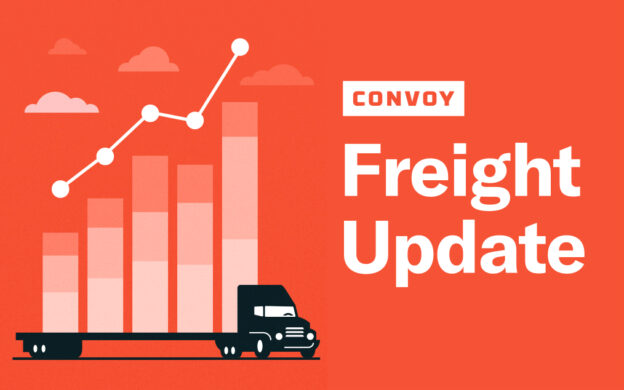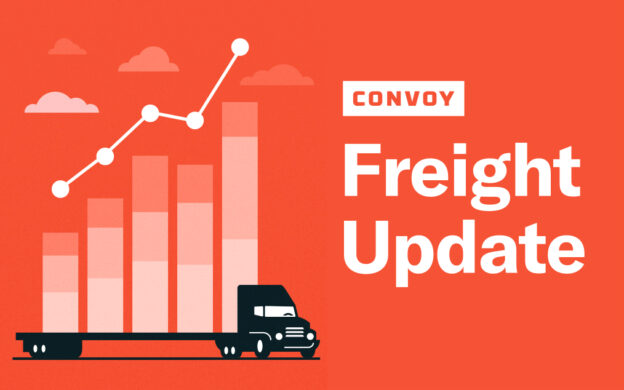COVID-19 Supply Chain Impact: An interview with Flexport Chief Economist Phil Levy
Freight Research • Published on April 7, 2020
Even before the COVID-19 pandemic, global trade was in turmoil. The toll of the two-year old trade war, combined with soft industrial demand abroad, was part of the reason why U.S. domestic trucking experienced soft demand in 2019. Much of the supply chain industry is looking to Chinese output for an early signal of what the economy recovery might look like.
Today we’re sharing the latest in our video series covering the ongoing coronavirus crisis and its impacts on the freight and supply chain industries. This video features our first guest from outside Convoy: Phil Levy, Chief Economist at Flexport, a modern freight forwarder with a global trade platform that’s used by over 10,000 clients and suppliers.
Subscribe to Freight Economics Updates to get the latest developments delivered directly to your inbox.
Convoy provides shippers reliable, flexible, and instant capacity when they need it most. Learn more about shipping with Convoy today.
View our economic commentary disclaimer here.

You can read the a transcript of the conversation below:
Aaron Terrazas: Welcome to Convoy’s ongoing analysis of the supply chain industry in the COVID-19 crisis. We’re recording on Monday, April 6th. I’m Aaron Terrazas with Convoy, and joining me today, we’re really excited for our guest. It’s Phil Levy, chief economist of Flexport, a modern freight porter with a global trade platform that’s used by over 10,000 clients and suppliers. Thanks for joining us, Phil.
Phil Levy: It’s good to be with you.
Aaron Terrazas: Phil, we’re all seem to be looking at the countries where this pandemic is further along for some signal about what lies ahead for both our infections, our health, and the economy. What, what are your data telling us about how the Chinese economy is evolving? To what degree is it reopening?
Phil Levy: Yeah, of course, we’re both watching the two dimensions, the epidemiological one and the trade one. We have data on trade. It got confusing at the start because the disease really spread throughout China during a time when they normally went quiet and that was during the Chinese New Year. What we saw in our data was the pause that normally comes with Chinese New Year, elongated. That there was a slowdown that continued for another week and then there was a recovery. It paralleled the recovery that we’d seen in previous years, but at a lower level. It was a partial recovery and China’s still had not gotten back as of a week or so ago to where they normally would have been relative to that Chinese New Year low.
Aaron Terrazas: Oh wow. So still, even as of this past week below average. I know that in our data we saw truckload demand outbound from some of the major China trade ports slow for much of January and February. Do you have any sense of when we can expect that those ships starting to arrive at those major ports?
Phil Levy: Yeah. Well, unfortunately this whole question of when will they get all the way and what’s going to happen has gotten entangled with what’s happened in the rest of the world. That it moved from being a China story and a China supply hang up to a global supply problem, then a global demand problem.
Phil Levy: One of the things that we’ve been seeing is that there have been a lot of canceled orders for the shipments coming across the Pacific. So there are shipments coming across. Ocean freight was moving. The problem has been that lots of cancellations. Canceled orders and that’s led lots of shipping lines to do blank sailings or cancel the string altogether.
Aaron Terrazas: That’s really interesting. It sounds like there’s a kind of complex response in supply, and how is that feeding into prices for I guess for both ocean and air freight?
Phil Levy: Yeah, good question. I think if you look at ocean, part of the reason for all the cancellations that we’re seeing of the sailings and the runs are an attempt to keep prices in a reasonable level, which otherwise might have plunged. Air, it’s a different story. With air, something like 50% of the capacity for cargo is actually traveling in the bellies of passenger planes. We’ve seen an enormous drop-off in passenger flights. So effectively, you’ve had air cargo capacity cut in half and you’ve seen prices go up a lot. It’s of course the method that you use if you have an emergency, if you want to transport, for example, personal protective equipment and you don’t want to wait, which for obvious reasons you don’t. It’s also the thing you do if you have a supply chain, you have inventories that have run low and you’re in a very big hurry to get a missing part is that you often turn to air. So there’s more incentive to turn to air and a dramatic reduction in capacity. We’ve seen prices triple or more.
Aaron Terrazas: Wow, triple or more. That’s impressive. How about North American supply chains? We’ve heard a lot of stories about, obviously travel border closures, but it seems like goods are still moving across the North American borders.
Phil Levy: Yeah, there’s been a concerted effort not to block goods along with people. The problem is sometimes as with the passenger air, they travel together. The other problem is you really need to have all the links of a supply chain working. This is what we saw in China in February, and I think we’re seeing this now. So you need to have, from the China standpoint, you needed to have not only the factories reopened, but workers, inputs coming in, truckers who moved things to ports, ports working.
Phil Levy: On the receiving end there, there’s a mirror image of that. That you need to have ports open, which for the most part they have, I think one of the things where we’re seeing problems are warehouses. It’s not an insuperable problem, but there’s an extent to which people are not eager to pick things up. You don’t need to stock a store that’s been closed for the last month and it looks that it’s going to remain closed the next couple of months and that’s been part of the problem. There have been issues of where the containers ended up and how much space there is in warehouses, but they haven’t stopped things, at least not so far.
Aaron Terrazas: Right. Really, really interesting. Thinking beyond the near term impacts. Obviously this pandemic hit the global trade system at a little bit of a weird moment. We are coming off a period of rising trade tensions that at least seem to be resolving themselves in December. Where do you think trade policy and global supply chains come out, out of all of this? Was this pandemic inflection point or we do we revert back to something more similar to how it was before?
Phil Levy: This is going to be a really big point of discussion. I don’t think that the tensions really resolved themselves. If you looked, it was at best a ceasefire, where everybody’s sort of held onto whatever ground they had already claimed. We saw, for example, between the U.S. And China with the Phase One deal, more or less, they froze tariffs in place. Slight reductions at the margin, but mostly you had all those tariffs heading into this.
I think there have clearly been some who have looked at this and concluded that this is an additional flaw they’ve spotted in globally dispersed supply chains. You’ve seen people like Peter Navarro at the White House make that case emphatically. I think that maybe worked a little bit if you were saying this was a China vulnerability, which it looked like at the very beginning of this. As this has spread out across the world, I think that’s much less compelling. I think what we’re actually seeing now is that needed goods, food in the lake are traveling around the world to the places that they are most needed, but that’s a big debate we’re going to have. Some people who are absolutely going to take this as justification for a move towards protectionism.
Aaron Terrazas: That’s really interesting and a lot more complex view than we’re often hearing. Beyond the trade policy, more specifically on Flexport, we’ve been inspired by what we’ve seen from Flexport.org and its efforts in getting critical supplies to frontline first responders combating this pandemic. I think when I checked the GoFundMe page this morning, you’ve already raised more than 6 million for frontline responders. Can you tell a little bit more about those efforts?
Phil Levy: Yeah. This was something where our founder and CEO, Ryan Petersen, felt very strongly that if we could help, we would and that we knew something about moving goods from China where you’re often getting the production of things like the personal protective equipment for doctors and frontline workers. So we had tried to step in, both raise funds, make connections where we can, but especially focus on how do we move things from where they are to where they need to be.
Aaron Terrazas: That’s great. That’s really inspiring. And Phil, on behalf of Convoy, I really want to thank you for joining us today and sharing your insights and expertise. I’ve really enjoyed our conversation and hopefully we get to speak with you again soon.
Phil Levy: Thank you for having me.
Aaron Terrazas: We’ll continue to provide regular updates on coronavirus and the supply chain industry. You can subscribe to the Convoy’s blog to stay informed. We’ll see you next time.


